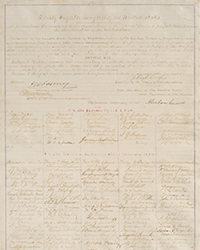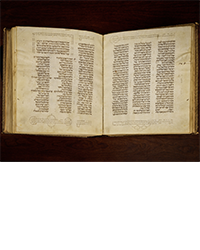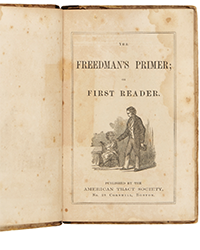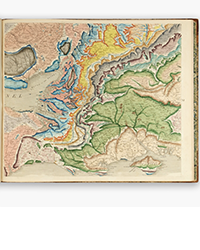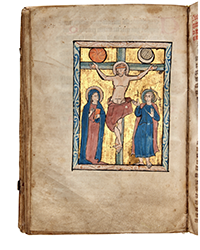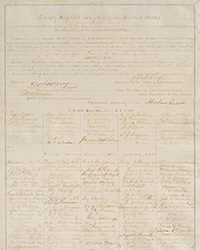The Veatchs Arts of the Book has released their Catalogue 100B Book Arts & Artifacts. They provide an introductory description so we will let them explain – “Catalogue 100B has something for everyone - collectors, libraries, printers, students of book arts programs. Rare ephemera, printers' necessities & type foundry specimens are some highlights.” We will look inside for a few examples.
We begin with the first American printers' guide by an American. As such, it is the first printers' manual with an American focus. The title is The Printers' Guide, Or, an Introduction to the Art of Printing including an Essay on Punctuation, and remarks on Orthography. It was printed in 1818 by C. S. Van Winkle, Printer to the University of New York. It contains prices and specimens of printing types from the foundries of E White and D & G Bruce. It includes the prices agreed upon for various types of printing by the Master Printers of New York (which sounds suspiciously like price fixing) and wages for different types of work, worker experience, etc. And, of course, what could be more exciting than an essay on punctuation? The Veatchs notes that the guide gives “a good picture of the printing trade in the U. S. during the hand press era.” This is a very rare item with the only copy sold at auction in the last century being a later reprint. Item 60. Priced at $22,500.
This was the first specimen book from American Type Founders, a combination of 23 type foundries, though that name does not appear. Published in 1892, its title is Point Specimen Book. Specimens of Printing Types, Rules, Cuts, Printing Material. The growth of type foundries led to serious price cutting in the 1880s, bringing about this consolidation that could control pricing. In this catalogue, type from seven foundries are offered. It could be purchased from one of its members, Dickinson of Boston, a leader in bringing about the consolidation. ATF came to control about 85% of the American market. This catalogue contains the reduced price list that was removed from later copies. Item 1. $3,000.
Next we will proceed through their early history and then all the way to their final downfall, a century later. Item 6 is a collection of material from the American Type Founders. It includes nine annual reports between 1895-1904 and one from 1915. There are two accounts published in 1902 celebrating their tenth anniversary. At the other end of the spectrum is The Auction of the Century from 1996, describing the auction of the now defunct ATF's assets. There are photographic views of their central plant and an inscribed copy of The Fall of ATF, A Serio-Comedic Tragedy by Theo Rehak, published in 2004. The Veaches notes that ATF went under almost 100 years to the day after its founding. It barely survived the Depression, and excellence of management was never a notable feature of this business throughout its lifetime, as it entered and exited various businesses along the way, including manufacturing presses. Item 6. $1,500.
This is a collection of 22 woodblocks from Harper's Weekly by political caricaturist Thomas Nast, the “father of political cartoons.” Nast is best known for his crusade against Boss Tweed and New York's Tammany Hall Democrats. Tammany Hall ran the Democratic Party in New York and with it effectively the city. It controlled government through its patronage. Corruption was not unknown to its leaders. In fact, it was its primary business. Nast constantly attacked Tweed and Tammany through his cartoons, and was a major fact in bringing about the downfall and imprisonment of Tweed. Tammany survived Nast's onslaught even if Tweed did not, and regained much of its power before finally being defeated by the Democratic reform movement in the 1960s. Nast was sympathetic to and sought to assist beaten down minorities, Blacks, Chinese, and Indians. He portrayed them favorably but abused by others. However, one group to which he was not sympathetic was the Irish immigrants. They played a major role in Tammany Hall and were not always kind to their black neighbors. Additionally, Nast had converted from Catholicism to Protestantism and the Irish were mostly Catholics. Nast was vehemently against religious involvement in the schools. These cartoons were mostly anti-Irish Catholic in sentiment, depicting the Irish as symbols of mobs and machine politics. Item 40. $4,000.
Next we have a game designed to remind us who invented the first printing press with movable type. No, it was not Gutenberg. It was Laurens Koster (or Coster), of Haarlem, the Netherlands, who died in 1440. He invented printing around 1423. One day, he was cutting letters in tree bark to entertain his grandchildren and noticed that when placed in the sand they left impressions. Ah hah! He invented a non-running ink, and then found he could create better letters in lead or tin. Now he had movable type. Koster had an assistant named Johann Fust. Fust stole Koster's invention as Koster was dying and later went into partnership with Gutenberg. And the rest, as they say, is history. Or fiction. The claim was not made until a century after Gutenberg and there is no evidence found of Koster's printing either contemporaneously to his time or any other time. Maybe Koster did invent printing, maybe someone else wrote Shakespeare's plays, and maybe Elvis is alive. Who can say? There are squares and circles on this game sheet engraved by Jacob Coldewijn in 1823. For Koster, they have attributes like honesty, love and humanity, and virtue. For Gutenberg and Fust there are disgrace, ingratitude, theft and crime. Other images include a printing press, Koster's garden and residence, and a book. Item 15. $1,500.
For those of you who still believe the Gutenberg story, here is a way of showing your support for the man from Mainz. Item 27 is a seven-inch tall bronze statue of Johannes Gutenberg by Gustav Gurschner of Vienna, from the early twentieth century. The marble base adds another 4 ½ inches to the overall height. It is questionable how accurate the portrayal is as there were no portraits of Gutenberg made while he was alive. $1,500.
The Veatchs Arts of the Book can be reached at 716-648-0361 or veatchs@veatchs.com. Their website is www.veatchs.com.


